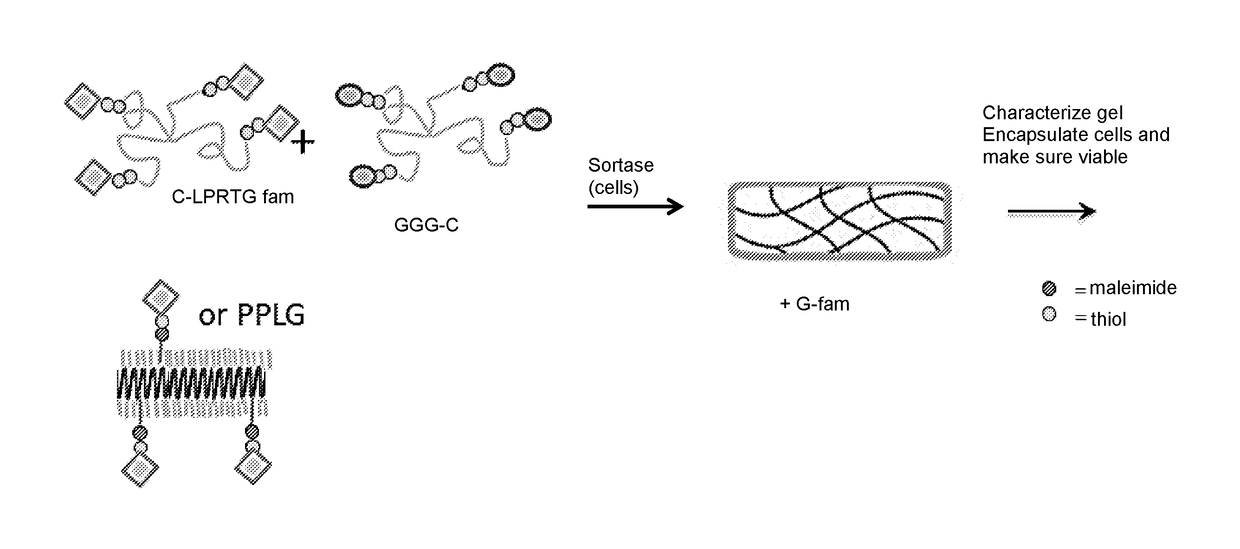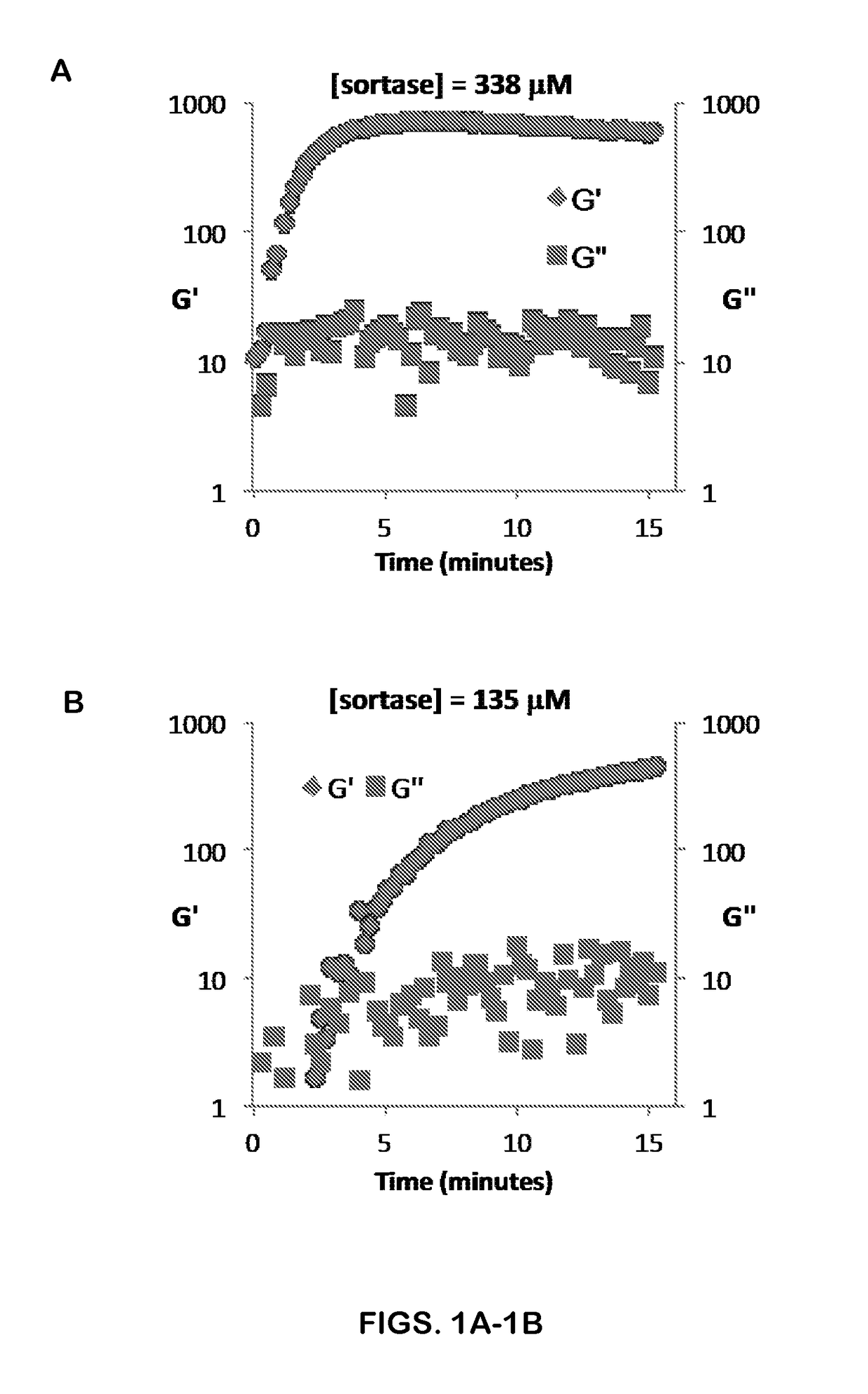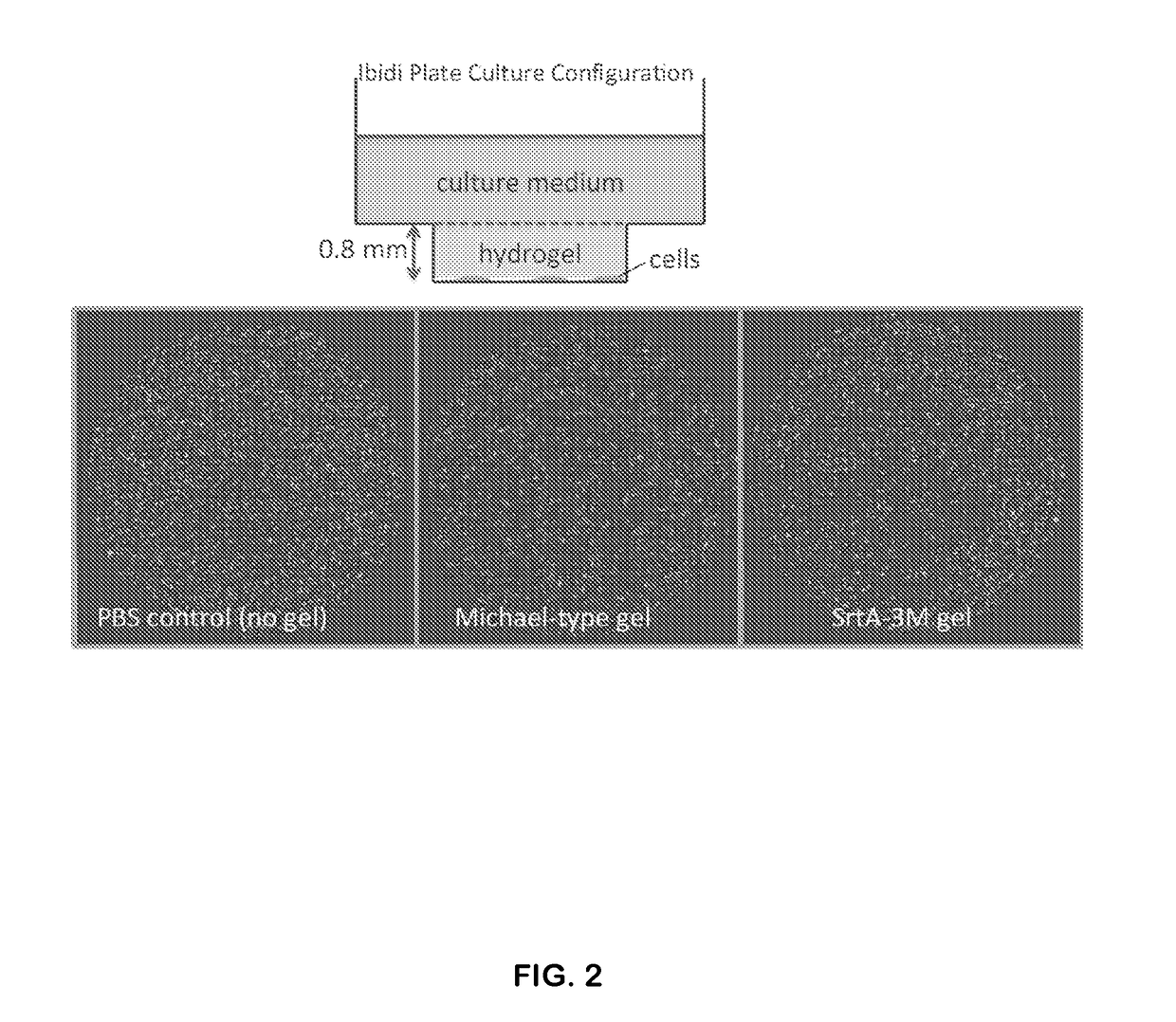Hydrogel Comprising A Scaffold Macromer Crosslinked With A Peptide And A Recognition Motif
a recognition motif and scaffold macromer technology, applied in the field of hydrogels, can solve the problems of variable success in minimizing cell damage, limited application to relatively thin tissues, and relative slowness, and achieve high specificity, accurate analysis and interpretation of cellular events, and high yield
- Summary
- Abstract
- Description
- Claims
- Application Information
AI Technical Summary
Benefits of technology
Problems solved by technology
Method used
Image
Examples
example 1
Hydrogel Formation Using SrtA
[0116]End-functionalized PEG macromers can be rapidly crosslinked by SrtA to yield mechanically robust hydrogels that preserve viability of encapsulated cells. FIG. 17 shows a schematic of sortase-mediated bulk crosslinking to form PEG hydrogels. As shown in FIG. 17, PEG polymers having C-LPRTG-fam at their ends crosslink with PEG polymers having GGG-C at their ends in the presence of sortase, forming a gel. Cells or tissue may be added to the polymer mixture with sortase to encapsulate them. The encapsulated cells or tissue may then be assayed for viability and / or for functional properties according to the methods described herein.
[0117]Three different SrtA mutants have comparable values of kcat (4.8-5.4 s−1), but different individual substrate affinities (Table 1 below from Chen et al., PNAS 108, 11399-11404, 2011), and therefore different relative forward and reverse kinetics. Other modified sortases with different kinetics and substrate specificity m...
example 2
Hydrogel dissolution Using SrtA
[0120]A. SrtA combined with a small peptide substrate leads to rapid gel breakdown.
[0121]Using gels formed by crosslinking 5 uL of precursor solution comprising 5 wt % macromer (338 μM SrtA-3M) in Eppendorf tubes in HEPES pH 7.4 with 10 mM CaCl2, reversibility was evaluated by adding 15 μl of one of the following at time zero: i) buffer; (ii) buffer+SrtA-3M (338 μM); or (iii) buffer+SrtA-3M (338 μM)+GGG (990 μM). The time of hydrogel dissolution was determined as the time at which the entire 20 μl volume could be pipetted up and down (n=2). In the presence of SrtA-3M and soluble GGG, the gel was broken down in 11 minutes, while the gel with SrtA-3M broke down in ˜2.5 hours. The hydrogel to which only buffer was added was stable after 4 hrs; SrtA was not washed out of this gel post-formation and was present at an average concentration of 85 μM. Thus, addition of soluble GGG substrate dramatically enhances the breakdown of the gel, pushing the kinetics w...
example 3
Functional Studies of Modified PEG Hydrogels
[0127]SrtA variants have been widely used for protein modification. The present invention provides methods of using SrtA-mediated coupling to effect, e.g., growth factor and adhesion ligand incorporation into PEG gels, thereby modifying the hydrogel to produce a 3D environment to support tissue morphogenesis in vitro. It has been previously shown that by combining sortase-mediated coupling and tetrazine ligation approaches, two epidermal growth factor (EGF) or two neuregulin-1 (NRG) moieties via PEG tethers can be efficiently linked over a range of PEG tether lengths (Krueger et al., Angew. Chem. Int. Ed. 53, 2662-2666, 2014). This was accomplished by developing high-yield (30-50 mg / L) expression protocols for EGF and NRG containing the relevant SrtA substrate motifs linked to the C- or N-terminus. Indeed, virtually any biomolecule may be incorporated (“tethered” and “functionalized”) into the hydrogel using the present methods. FIG. 16 sh...
PUM
| Property | Measurement | Unit |
|---|---|---|
| time | aaaaa | aaaaa |
| time | aaaaa | aaaaa |
| time | aaaaa | aaaaa |
Abstract
Description
Claims
Application Information
 Login to View More
Login to View More - R&D
- Intellectual Property
- Life Sciences
- Materials
- Tech Scout
- Unparalleled Data Quality
- Higher Quality Content
- 60% Fewer Hallucinations
Browse by: Latest US Patents, China's latest patents, Technical Efficacy Thesaurus, Application Domain, Technology Topic, Popular Technical Reports.
© 2025 PatSnap. All rights reserved.Legal|Privacy policy|Modern Slavery Act Transparency Statement|Sitemap|About US| Contact US: help@patsnap.com



